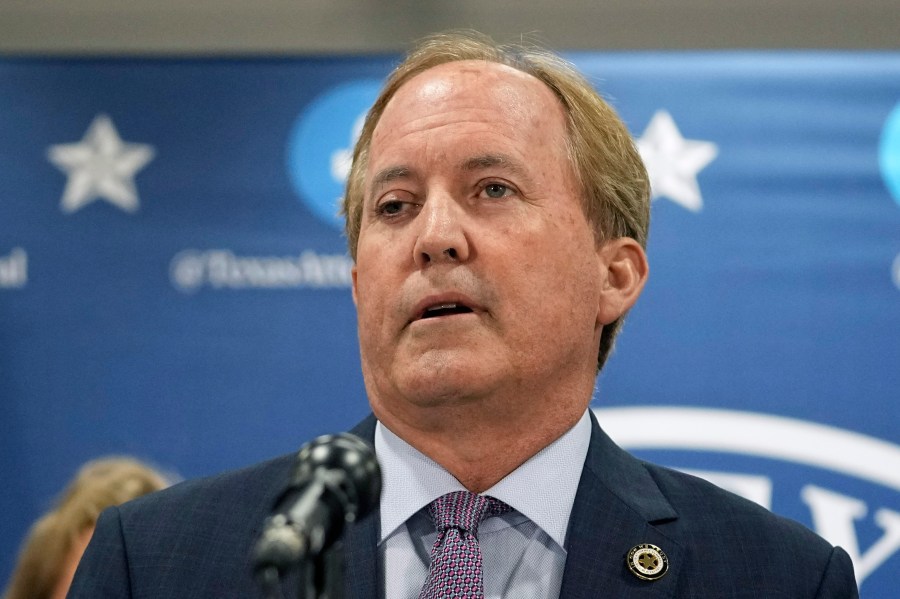
State of Texas: New details about Paxton accusations revealed in documents
AUSTIN (Nexstar) — In late July, lawyers for Ken Paxton submitted motions to dismiss the articles of impeachment facing the suspended Attorney General. Paxton’s team argued in part that removing him from office would unfairly overrule the will of Texas voters, saying voters elected him, even though they knew about the allegations against him.
Late Thursday night, the House impeachment managers released nearly 4,000 pages of exhibits after teasing for months that “damning” evidence to back their case for removal from office. The documents include new details into the accusations that Paxton abused his office to help campaign donor Nate Paul.
Managers on Wednesday began to release new evidence, after publicizing allegations they say show Paxton went to great lengths to conceal his relationship with Paul — an Austin real estate investor at the center of Paxton’s corruption allegations — even though top officials in the Office of Attorney General had warned Paxton numerous times that Paul was a “crook.”
In one interview from the exhibits, a former deputy attorney general said Paxton was “literally obsessed” with helping Paul, while “tying up resources of the most senior people in the agency during a pandemic where there was substantive, real issues going on.” That staffer was also among the whistleblowers, which consisted of top executive staff who first accused Paxton of corruption and abuse of office.
The Senate posted the House managers’ new exhibit records to the court of impeachment website, which manages motions and documents related to the trial. The House’s records were dated for Tuesday, the deadline for pretrial motion responses, but not made public until Thursday evening.
The documents also claim that Paxton used his office’s public information powers to help Paul access a sealed FBI search warrant for Paul’s properties.
Former trial lawyer Mike Golden — who also serves as Directory of Advocacy at the University of Texas School of Law — said based on the new exhibits, House managers and prosecutors might have a compelling case.
“Given that the attorney general’s office is the state agency that is responsible for enforcing our state’s open records laws, for the head of that agency to take deliberate steps — assuming that it’s true, right, assuming the allegations are true — to take deliberate steps to avoid the scrutiny of the public records law that his office is designed to enforce, seems to be a particularly egregious use of his resources,” Golden said.
At the end of May, the House overwhelmingly voted to impeach Paxton 121-23, causing his immediate suspension from office. No aspect of the trial will include criminal charges; senators’ vote will determine whether or not Paxton must be permanently removed from office. The allegations against Paxton include bribery, abuse of office, and obstruction. The Republican has faced controversies and criminal charges hanging over his tenure.
A few weeks ago, Paxton’s attorneys filed motions seeking to dismiss all 20 articles of impeachment largely on the premise that the House lacked sufficient evidence. Paxton’s team has also argued that the public was aware of those allegations and that the accusations pre-date his most recent election to office. It’s a legal interpretation of the Texas Constitution that says state officials cannot be impeached based on accusations before their election to office. However, the law does not specify if it means most recent election or first election to that particular office.
The new exhibits offer previously unknown information about Paxton’s relationship with Paul — giving senators much more information about the case to consider just weeks before the trial starts on Sept 5.
Lt. Gov. Dan Patrick will decide on whether to grant these all of the pre-motions, except for team Paxton’s request to dismiss the articles of impeachment. That requires a majority vote in the Senate.
Families call for change after deaths of loved ones in state custody
As Tona Naranjo raised a faint candle toward the Governor’s Mansion, she remembered the light of her life now extinguished.
Gathered in prayerful protest on the steps of the mansion on Friday night, she mourned with other families who have lost loved ones inside the criminal justice system.
Her son, Jon Anthony Southwards, died at 36 years old on June 28 inside the Texas Department of Criminal Justice’s Estelle Unit. He was found unresponsive in his cell and later pronounced dead. His cause of death is still unknown, pending autopsy results from a medical examiner.
Naranjo is seeking answers from TDCJ regarding the circumstances of her son’s sudden death.
“That little boy taught me what unconditional love was all about. He taught me what passion was. He taught me what it was like to be a sovereign servant,” she told a crowd of families and inmate advocates Friday. “A judge sentenced Jon Anthony to 20 years. The TDCJ Estelle Unit sentenced Jon Anthony to death.”
Southards is one of at least 202 people who have died while incarcerated inside Texas correctional facilities since June 1.
Nexstar analyzed the 135 reports involving deaths in TDCJ prisons, the majority of which are not air-conditioned, amid concerns that this summer’s extreme heat may be exacerbating or triggering medical issues.
Custodial death reports from the Texas Attorney General’s Office show at least 51 people appear to have died after a sudden and unforeseen medical distress in the last two and half months.
Of those 51 deaths, 11 died of cardiac arrest or heart failure. In 38 cases, the cause of death is unknown or pending autopsy results.
35 people were pronounced dead after TDCJ staff found them unresponsive in their cells. Of those inmates, eight were determined to have died of cardiac arrest, one of cardiogenic shock, and the 27 others have “pending” or “unknown” causes of death.
20 of those 35 people were under 50 years old. 14 were under 40 years old.
The youngest deceased inmate was 23-year-old Peyton Pendley. He was found unresponsive in his cell at TDCJ’s Beto Unit on July 12 and was later pronounced deceased at a hospital.
The average age of these deceased inmates is 51 years old.
TDCJ has not documented any deaths as heat-related since 2012.
“Inmates and staff found in medical distress immediately receive medical attention via EMS or the infirmary,” TDCJ spokesperson Amanda Hernandez told Nexstar. “TDCJ does not determine cause of death, this is determined by an independent medical examiner. Based on this, TDCJ has not had a heat-related death this year.”
Hernandez said TDCJ recorded 110 deaths in June and July of this year, out of a population of 128,777. For comparison, last year saw 99 deaths in the same months out of a population of 121,102, she said.
Below is the list of TDCJ deaths that occurred in prison facilities since June 1. This list excludes suicides, homicides, and natural illnesses. It also excludes deaths that occurred inside air-conditioned units or in the prison system’s hospitals.
Experts believe TDCJ is undercounting heat-related deaths.
“On its face, that doesn’t make sense,” said Michele Deitch, who directs the Prison and Jail Innovation Lab at the University of Texas LBJ School of Public Affairs and co-chairs the American Bar Association’s Subcommittee on Correctional Oversight. “We can see how deaths spike during the summer months. TDCJ may not have proof that these were heat-related deaths, but on its face, it doesn’t make sense to say that they are not related.”
Deitch cited one study that found approximately 13 percent of deaths in Texas prisons during warm months between 2001 and 2019 may be attributable to extreme heat. The study concluded that air conditioning for Texas prisons “may be an important part of protecting the health of one of our most vulnerable populations.”
“In fairness, some of these may be drug-related deaths. And we have to at least acknowledge that possibility,” Deitch said. “But common sense tells us that when the heat is this extreme, and you’ve got people without prior medical conditions dying that young in their cells, there may well be a connection to the heat.”
‘Offering common sense,’ Texan makes case to GOP presidential primary voters who want an option to Trump
On Wednesday, Republican candidates for president are scheduled to meet on stage in Milwaukee for the first debate leading up to the 2024 primary. The only Texan in the race, former Congressman Will Hurd, is still trying to earn a spot on the stage.
Candidates have to meet requirements for polling and campaign contributions to participate in the debate. Candidates must register at least 1% support in three national polls or a mix of national and early-primary state polls. They also must have campaign contributions from at least 40,000 donors.
Hurd recently passed the donor threshold. On Wednesday, he hit the 1% in a poll released by Quinnipiac University, putting him closer to the polling requirement.
“I feel good that folks are going to be able to see me on the debate stage,” Hurd told KXAN’s Jennifer Sanders during an interview Wednesday afternoon.
But there’s one other requirement that could keep Hurd off the debate stage. Debate participants have to sign a pledge that they will support the eventual GOP nominee. Hurd says he won’t sign the pledge.
“My issue is not that I’m going to say, I won’t support the Republican nominee. My issue is I won’t support Donald Trump,” Hurd said. He pointed out that Trump himself refused to sign the pledge.
Hurd said once his campaign meets the other requirements he would try to reach an agreement to take part in the debate. “We’ll engage with the RNC and see how the process evolves. I mean, in my adult life, I’ve never signed a contract that I didn’t have amendments to,” Hurd said.
Hurd has made a point of criticizing Trump in his campaign. He told an audience in Iowa that Trump was running for president to stay out of prison. The statement was met with loud booing from the crowd. Despite the response, Hurd stands by his position and approach to the campaign.
“I’m not a political scientist, but I have won tough elections, and you don’t win an election by kissing your opponents behind,” Hurd said.
He pointed to polling that shows while Trump has high popularity among Republican voters, he has higher negative numbers among independents and Democrats. Hurd believes the Republican party needs to move on from Trump.
“What most voters want, whether you’re Republican voters, independent voters, or Democrats who are frustrated with the direction of the Democratic Party, you want someone who’s not afraid of Donald Trump, but who’s also articulating another vision for the future,” Hurd said.
Districts struggle to cover cost of law mandating armed officers on campus
After a mass shooting killed 19 children and two teachers at Robb Elementary in Uvalde, a school district four hours away in Jarrell started the process of getting shatterproof film on the windows of its high school.
The invoice, according to the superintendent, was $50,000.
Jarrell Middle School campus (KXAN Photo/Chris Nelson)
With the passage of the state’s latest school safety bill, House Bill 3, lawmakers handed districts new requirements to place one armed officer on every school campus and bring campuses up to new safety standards.
But some districts KXAN spoke with are struggling to come up with the money and personnel to comply with the new law by the time it goes into effect Sept. 1.
“Everybody recognizes safety for our children is the number one priority. We all say it — but to prove that, the dollars have to follow,” said Jarrell ISD Superintendent Dr. Toni Hicks.
The original bill authored by Rep. Joe Moody, D-El Paso, proposed increasing the school safety allotment by $90 per student.
But, after back and forth with the Senate, lawmakers approved a plan to increase the per-pupil safety funding by 28 cents, meaning under the new law districts would get $10 per student instead of $9.72
The plan also gave districts $15,000 per campus to spend on officers or any other safety enhancements. Some districts received grants from the Texas Education Agency.
Hicks said, luckily, the district just approved a bond. But she says districts without those funds will have difficulty paying for officers and security upgrades.
“We put security cameras in every building and on the exterior of the building. We are adding artificial intelligence to those cameras. That’s expensive,” Hicks said. “Other districts who hadn’t done that yet — they are faced with that. Well, just those two expenses certainly exceed that $15,000.”
An hour south of Jarrell, at Hays CISD, the Head of District Safety Jeri Skrocki says she is struggling to find money and personnel to put an officer on each of her 15 elementary campuses currently without a dedicated sheriff’s deputy.
Head of District Safety Jeri Skrocki (KXAN Photo/Chris Nelson)
“We had actually funded three positions that we put on last school year. Unfortunately, because of staffing shortages, the sheriff’s office wasn’t allowed or wasn’t able to staff two of those positions for the entire school year,” Skrocki said.
“So, we had foreseen those holes right after Uvalde,” she continued.
Other school districts in Hays County, like Dripping Springs ISD, are also vying for more school resource officers from the same sheriff’s office to comply with the law.
The Hays County Sheriff’s Office has not responded to our request for comment.
“If we can find officers, where and how were we going to pay?” Skrocki asked. “I don’t believe you are going to be able to see a lot of police agencies across the state of Texas be able to promise an officer at every school.”
Since the day of the Robb Elementary shooting, more than 15 school districts began participating in the state’s school marshal program, according to the Texas Commission on Law Enforcement. The program trains school employees to protect students from armed intruders.
More than 50 school districts have applied to create a certified police department since the mass shooting, according to TCOLE.
Hicks’ district is one of them.
Jarrell School Board approved a plan to pay for third-party armed security guards on every campus to comply with the law, while the district’s new police chief hires officers for its new police department. The district said it will be compliant with House Bill 3 on the first day of school with this plan.
“It costs somewhere around $100,000 per officer just to get them equipped, get them trained, and put them on campus,” Jarrell ISD Police Chief Sharif Mezayek said. “Right now, it is very difficult to find officers. Where are these officers going to come from?”
Austin Independent School District, which already has its police force, is looking for 70 more officers ahead of the law taking effect.
Del Valle School Board, in July, approved a $1.1 million plan to hire nine additional officers in a rush to comply.
During a school board meeting, one Del Valle parent begged the school board to not lower its standard for officers during the hiring process because of the new requirements.
“Stick to the current level that we have right now. Our standards should not fall,” Efrain Garza said.
Map showing the number of officers each school district needs to add to its force to comply with the school safety bill’s requirements. KXAN reached out to each of the school districts on the map for this information on July 24, 2023 and received the above information on or before July 31.
“We need someone who can work in the gray area with kids,” Mazeyek said. “You have to have a person that wants to work with kids and work with the ups and downs that go along with that and not always be so quick to put them in jail.”
The school safety bill was signed into law in June — leaving the districts with less than three months before the law would become effective.
The Texas Education Agency provided guidance for districts for the first time in July.
The law allows for school boards to claim a good cause exemption if the district can’t find the funding or personnel to comply with the law, but the district has to come up with an alternative plan.
The law doesn’t require districts to submit the claim to the Texas Education Agency, but if requested by TEA — the claim has to be made available.
Districts could also face state intervention for non-compliance, according to the law.
Bastrop Independent School District’s Deputy Superintendent said in an email to KXAN that her district will claim a good cause exemption and a multi-year plan for how it will achieve compliance. We plan to follow up with the state to see how many districts made this claim this school year and what next steps will happen.
The Texas legislature will come back for a special session focused on education in October, but priorities haven’t been announced and it’s unclear if lawmakers will revisit the school safety legislation. We plan to follow up with lawmakers and other state leaders about the financial challenges districts shared.
[#item_full_content]

